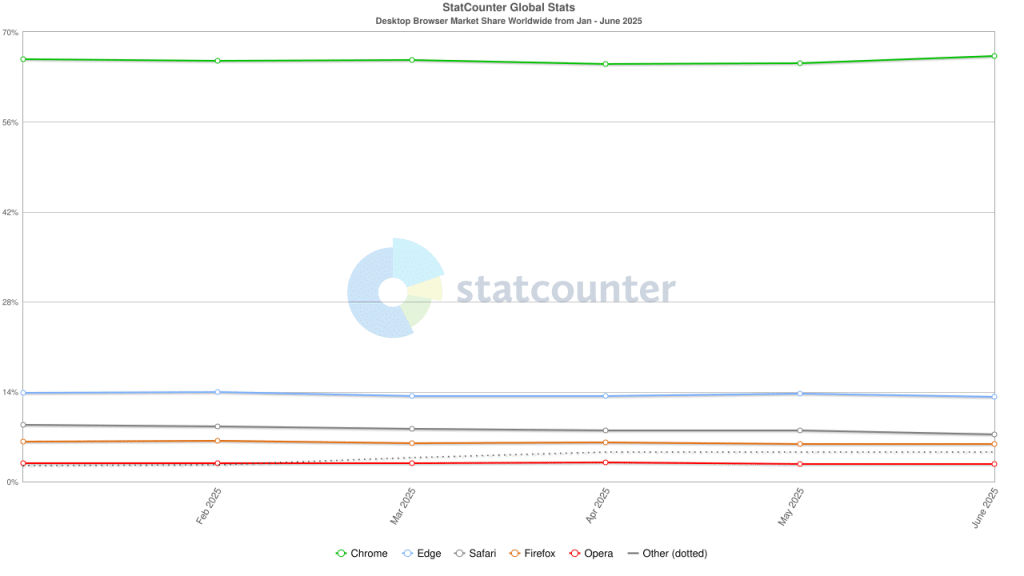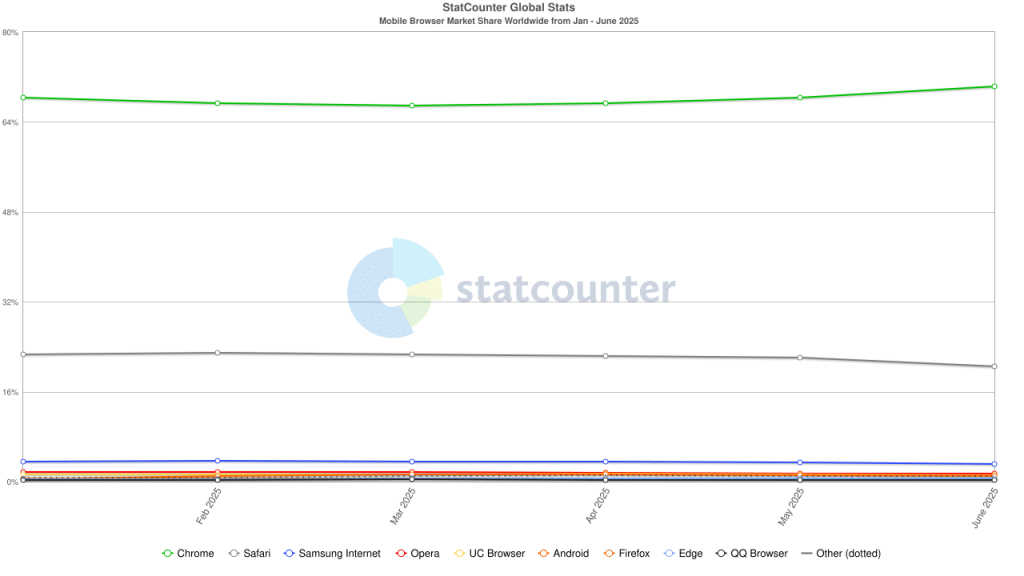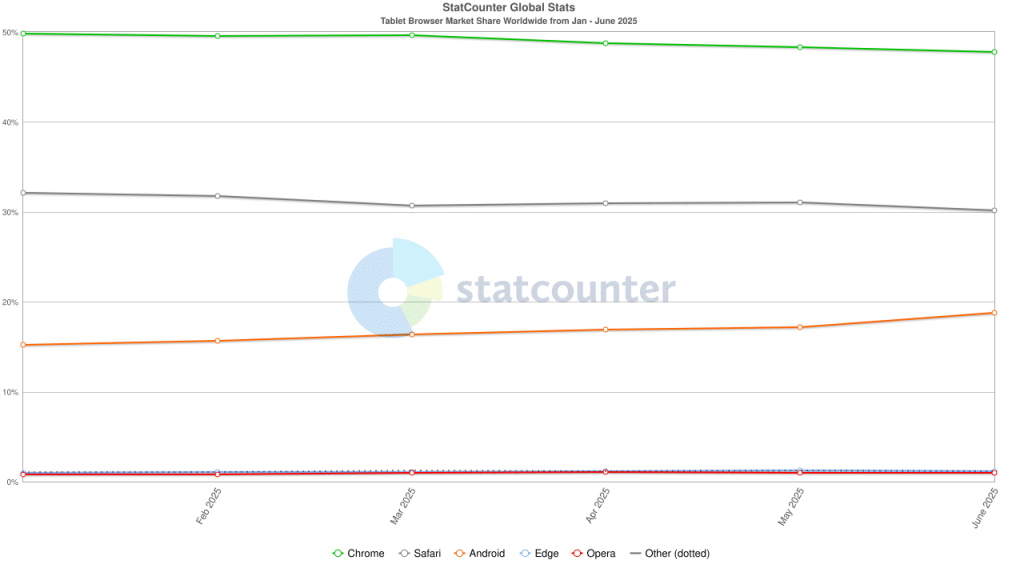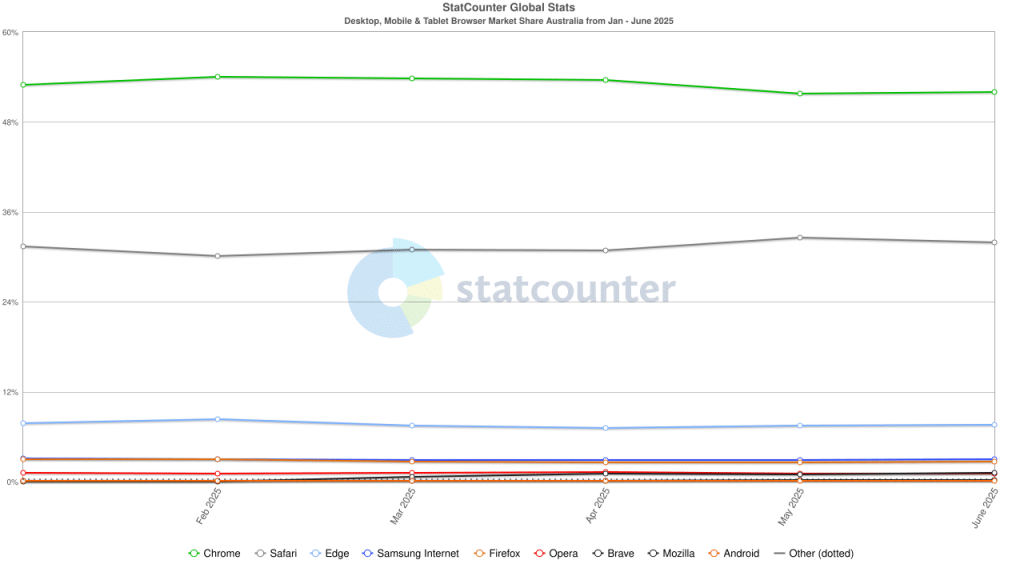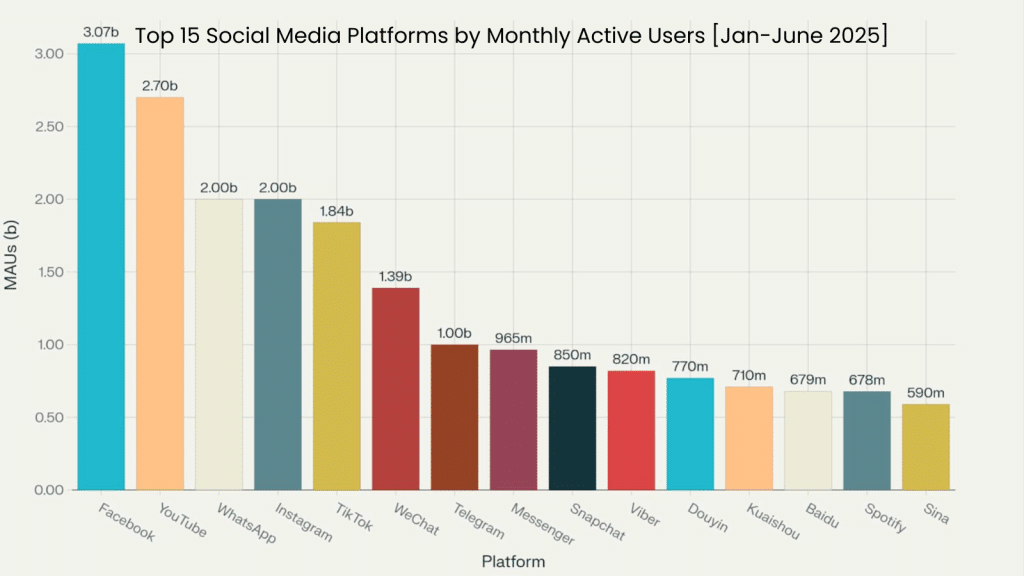Internet Usage Trends [Jan-June 2025]
Leveraging Data for Business Growth
As we hit the mid-point of 2025, it’s crucial for businesses to stay informed about the latest internet usage trends. By understanding how users interact with the digital landscape, you can make data-driven decisions to optimise your presence and drive growth.
Let’s look the key trends shaping the internet between January to June 2025 and provide actionable insights to help your business stay ahead of the curve.
Browser Market Share Worldwide [Jan-June 2025]
Desktop Browser Market Share: Chrome Continues to Dominate
Chrome maintains its position as the leading browser across desktop, mobile, and tablet devices, with a global market share of over 65%. This dominance highlights the importance of ensuring your website is optimised for Chrome to provide a seamless user experience. However, don’t neglect other browsers like Safari and Firefox, which still hold significant shares, especially in specific regions or demographics.
Mobile Browser Market Share
As of June 2025, Chrome dominates the global mobile browser market with over 65% share, followed by Safari around with 22%. Samsung Internet holds just over 3%, while Opera, UC Browser, and Android each have less than 2%, highlighting a highly consolidated market led by two main browsers.
Tablet Browser Market Share
Chrome led the global tablet browser market with just over 48%, followed by Safari at 31% and Android at 17%. Edge, Opera, and Yandex Browser each held less than 2%, indicating a competitive landscape with Chrome’s lead less pronounced than on mobile or desktop.
Browser Market Share Australia
Chrome led Australia’s browser market, just shy of 52%, followed by Safari at 32%. Edge held 7.53%, Samsung Internet almost 3%, Firefox 2.54%, and Opera hovering at 1%. The market is dominated by Chrome and Safari, with other browsers maintaining only minor shares.
Device Market Share Worldwide [Jan-June 2025]
Mobile-First Mindset: Prioritising Mobile User Experience
Mobile devices continue to be the primary means of accessing the internet, accounting for 63% of global internet traffic. This trend emphasizes the need for businesses to adopt a mobile-first approach in their digital strategies. Ensure your website is optimised, fast-loading, and easy to navigate on mobile devices to cater to the growing mobile user base. Hone your content and user interface for smaller screens and touch-based interactions.
Social Media Stats Worldwide [Jan-June 2025]
This bar graph depicts of the Top 15 Social Media platforms worldwide by Monthly Active Users (MAUs) in 2025. Facebook leads with over 3 billion active users, followed by YouTube, WhatsApp, and Instagram with over 2 billion users each. Messaging apps like Telegram and Messenger also rank highly among the top platforms worldwide.
- Facebook – 3.07 billion MAUs
- YouTube – 2.53 billion MAUs
- WhatsApp – 2.00 billion MAUs
- Instagram – 2.00 billion MAUs
- TikTok – 1.59 billion MAUs
- WeChat – 1.34 billion MAUs
- Telegram – 900 million MAUs
- Messenger – 965 million MAUs
- Snapchat – 850 million MAUs
- Viber – 820 million MAUs
- Douyin – 770 million MAUs
- Kuaishou – 710 million MAUs
- Baidu Tieba – 679 million MAUs
- Spotify (Tencent) – 678 million MAUs
- Sina Weibo – 590 million MAUs
CMS Usage Distribution [Jan-June 2025]
WordPress Leads, but Diversity Thrives
WordPress remains the most widely used Content Management System (CMS) worldwide, powering over 40% of websites. Its extensive ecosystem of themes, plugins, and community support makes it a popular choice for businesses of all sizes. However, the Australian market shows a more diverse CMS landscape, with platforms like Squarespace and Wix gaining significant traction.
Consider your specific needs and target audience when choosing a CMS, and explore emerging headless CMS options for greater flexibility and performance.
eCommerce Platform Usage [Jan-June 2025]
Shopify Dominates, WooCommerce Rises in Australia
Shopify continues to be the leading eCommerce platform globally, with a market share of over 30%. Its user-friendly interface, extensive app marketplace, and robust features make it a top choice for online stores. However, in Australia, WooCommerce and Squarespace Add to Cart have a stronger presence compared to the global average. If you’re targeting the Australian market, consider these platforms as viable alternatives to Shopify, depending on your specific requirements and integration needs.

TL;DR
- Optimise website for Chrome, but test across browsers to provide a consistent user experience
- Adopt a mobile-first approach in your website design, content strategy, and marketing campaigns. Regularly test your site’s mobile performance and improve accordingly
- Evaluate your specific requirements, scalability, and target audience when selecting a CMS. Consider factors like ease of use, customisation, and integrations
- If you’re running an online store, choose an eCommerce platform that aligns with your business goals, target market, and growth plans. Consider factors like user experience, payment gateway options, and marketing features
- Regularly track and analyse KPIs such as website traffic, engagement rates, conversion rates, and customer lifetime value. Use these insights to optimise your strategies and allocate resources
Online Data Is Our Oxygen
By staying informed about internet usage trends and adapting your digital strategies accordingly, you can position your business for success in the ever-evolving online landscape. Remember to continuously monitor your performance, gather user feedback, and iterate your approach based on data-driven insights.
At Clickify, we’re committed to helping businesses navigate the digital landscape and achieve sustainable growth. If you need assistance in leveraging these internet usage trends for your business, our team of experts is here to help. Contact us today to discuss your digital marketing strategy and unlock your online potential.


